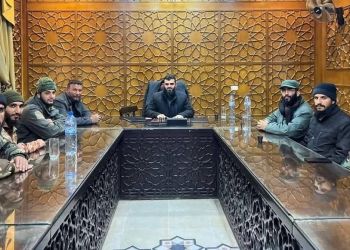Studies – Position Assessing
Assassinations targeted Syrian Democratic Forces (SDF)’ commanders in areas in Deir Ezzor, east of the Euphrates. Three operations occurred in one day. On the other hand, the SDF and International Coalition conducted airdrops and raids, arresting dozens of Daesh commanders in October 2020. Daesh’ assassinations not only target military personnel alone, but also civil agents in the Deir Ezzor Civil Council and tribal dignitaries, amidst a public’ anger with deteriorated security conditions, especially in the eastern Deir Ezzor countryside whose infrastructure is fragile.
This article addresses recent security situations and puts them in context with their influence on Deir Ezzor’ society. On October 31,2020, Daesh launched intensified attacks in Deir Ezzor, one of them killed a fighter and injured others of the SDF’ Fighting Terrorism HAT forces on the way to the al-Omari oil field. In another attack, Daesh killed an SDF commander in the Markadah area in al-Hasakah. A Daesh’ bomb targeted the Deir Ezzor Military Council commander in the city of al-Hasakah.
Daesh escalated the attacks after the International Coalition and SDF intensified arrests, raids, and airdrops against it in areas east of the Euphrates.
Daesh launched attacks and assassinations in different areas with multiple styles. As Daesh operations were in the style of members’ using weapons on motorcycles to assassinate people, the organization turned to focus on planting landmines. In one of its operations against the HAT forces, Daesh used a landmines chain that explodes respectively. The chain is locally named al-Masbaha.
The al-Masbaha (Chain) landmines and Daesh active cells:
al-Masbaha (Chain) landmines is a chain of landmines that explode respectively once one of the landmines explodes. Daesh used such a strategy in the al-Baghouz battle that resulted in expelling the organization and liberating Deir Ezzor. The return of these landmines is a new development in Daesh’ operations against the SDF and the agents of the Deir Ezzor Civil Council. The return of these landmines indicates severe blows dealt to Daesh by the SDF and International Coalition’ qualitative operations against Daesh members and commanders.
The coincided timing of Daesh operations in three spaced areas has a significant organizational indication, as Daesh groups are on a high level of communication and their targetings are severe and bear clear messages.
First: Targeting HAT forces:
Daesh used the al-Masbaha (Chain) landmines that explode respectively in targeting the HAT forces. The attack killed a member of the HAT forces that are special for chasing and arresting Daesh groups’ members. The al-Masbaha (Chain) landmines is one of the extremist Daesh strategies in al-Baghouz battles. This is the second time that Daesh uses this strategy after battles in al-Baghouz. This strategy reflects how Daesh is operative in the Deir Ezzor countryside in an attempt to respond to the severe qualitative operations by the SDF and International Coalition.
Second: the assassination of Idriss Riad, a leader of the SDF known as “Abu Riad”, near the sheep market in Markada town, south of Al-Hasakah on the border of Deir Ezzor, and the killing of two of his escorts. Riad is a commander of several brigades. The operation in which he was targeted is similar to most of operations the group carries out in Deir Ezzor countrysides, by shooting from a motorcycle. It is the group’s preferred method as motorcycles are fast and can hide easily in the villages.
Third: The assassination attempt against the commander of the SDF-linked Deir Ezzor Military Council, Ahmed al-Khubeil, known as Abu Khawla. Although he survived it, but targeting al-Khubeil in al-Hasaka city indicates that the organization knows the SDF movements, and possibly has infiltrated its ranks to some extent.
Intensive security operations
The SDF’s counter-terrorism forces (HAT), backed by the coalition aircraft, carried out an operation it described as “qualitative” on November 2 in Al-Sabha town in the eastern Deir Ezzor countryside. During the operation, the HAT arrested 20 people. According to its sources, local media network Deir Ezzor 24 said that all those who were arrested were on the wanted list of the coalition and the SDF. Preliminary investigations showed that there were signs on the clothes of some of the arrested persons confirming that they were working in preparing explosive devices.
Other media sources reported that one of arrested was a senior security leader of the organization, Abu Jihad al-Ansari, and that he was managing Daesh cells’ movements in Deir Ezzor.
On 4 October, Asharq Al-Awsat newspaper quoted SDF leaders as saying that security operation against the group resulted in the arrest of three leaders, including the zakat and finance emirs, in addition to other one responsible for planning assassinations in Deir Ezzor.
Colonel Wayne Marotto announced through his personal Twitter account that they had carried out more than 100 operations against Daesh, and confirmed that they had “managed to deter 67 Daesh leaders and 41 terrorists from committing terrorist acts”.
Painful blows – What awaits the people of Deir Ezzor
Daesh cells are trying to direct painful blows to the coalition and the SDF, through targeting all those cooperating with the military council and the coalition, the workers of and tribal dignitaries cooperating with Deir Ezzor Civil Council, and patrols, checkpoints and members of the SDF, but the coalition and SDF’s intensive security operations struck hard at Daesh cells.
These operations caused a state of anger among the population of Deir Ezzor. People are protesting against the poor security situation in the region, as they found themselves paying the heaviest price after the military defeat of Daesh in Syria.
The coalition and the SDF are trying to focus more on military and security operations, but they have neglected other aspects like education, health, reconstruction, creation of job opportunities, and controlling chaos and insecurity, especially in the eastern Deir Ezzor countryside.









